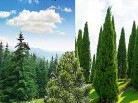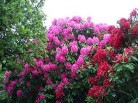

Climate of Bhutan
Bhutan is a small country located in the heart of the great Himalayan mountain range. In spite of being small, the country's climate is not same throughout which could be expected if we look into the mere size of the country. In fact Bhutan is a country with amazingly varying climatic condition owing to the geography of the country which starts from the low lying southern foothills to great giants of Himalaya mountain peaks with climatic condition varying from semi tropical in the south to alpine in the north The south is usually hot and humid during summer with average temperature of 30 degree Celsius accompanied by monsoon rain, while the winter are usually cool and dry with temperature ranging at around 15 degree Celsius. As we move towards north the temperature starts decreasing that is for every 1000 m rise in the altitude temperature drops by 7 degree Celsius. A plan to visit the southern foothill is best at winter unless you don't mind the temperature and humidity of summer while the best time to visit central Bhutan are during spring which starts from march till may and autumn from September to November. Winters are very cold in central Bhutan and if you are planning to visit then you will need some warm clothes to protect yourself from the chilling winter temperature. But regardless of whatever the season may be, having a few warm cloths would never be a bad idea, since evenings and morning are sometimes chilling too.
Towards the north lies gigantic lakes and snow covered mountains which is the home to the rare and majestic snow leopards. And below those great mountains lies the villages of our semi- nomadic herders called Bjops, who lives along with a rare cattle like beast called yaks (unlike their southern cousins, yaks are characterized by very long and dark hair on their body which protects them from the cold climate). The climate in this region is very cold with the average temperature of just around 10º C and if you are planning to visit the north to view the beauty of the great Himalayan mountains, lakes and rare snow leopards then remember to pack thick coats and gloves along with warm socks and boots and anything else to keep yourself warm.






















